March 31, 2014
Social Vision in an Era of Population Decline from the Perspective of Local Economy and Well-being
Keywords: Newsletter Steady-State Economy
JFS Newsletter No.139 (March 2014)
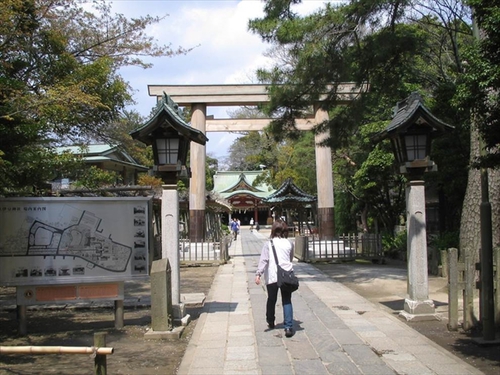
Copyright Yoshinori Hiroi All Rights Reserved.
In fiscal 2013, Japan for Sustainability (JFS) worked on a Local Well-Being Project as one of its activities. This issue of the JFS Newsletter introduces a translated summary of the keynote speech at the "Thinking about Happiness at the Local Level" symposium held on February 6, 2014 in Tokyo. Prof. Yoshinori Hiroi of the Social and Health Policy Department, Faculty of Law and Economics, Chiba University.
---------------------------------------
Social Vision in an Era of Population Decline -- Localization Beyond Globalization
Lecture by Prof. Yoshinori Hiroi, February 6, 2014, Tokyo
The essence of issues Japan now is facing is population decline and an aging population. Japan is one of the world's frontrunners of these issues; therefore I think it is meaningful not only for us but for the world as well to know how Japan tackles them. It is true that population decline presents a huge challenge. To me, however, there seems to be some positive potential, and this could be a turning point, a chance to go in an opposite direction from which we have come.
According to a graph of Japan's population, we can see that while it remained at around 30 million people during the Edo Period [1603 to 1867], it started to rapidly increase at the end of that period, and kept going up until 2004, when it reached a peak. After that it started to decline, and is expected to fall to under 100 million people in 2050 if the population decreases at the same pace. On one hand, I am worried about what will happen in the future. On the other hand, however, I wonder how hard we pushed ourselves to go uphill in the past. Although we achieve a certain degree of wealth, we also absorbed considerable difficulties and contradictions.
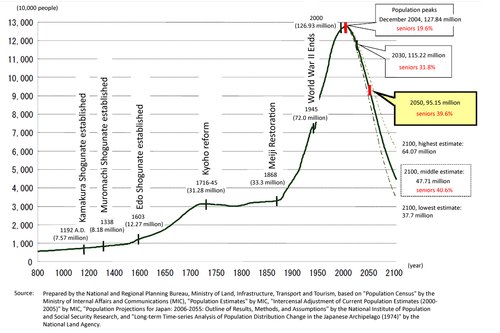
Copyright Yoshinori Hiroi All Rights Reserved.
Source: Prepared by the National and Regional Planning Bureau, Ministry of Land, Infrastructure, Transport and Tourism, based on "Population Census" by the Ministry of Internal Affairs and Communications (MIC), "Population Estimates" by MIC, "Intercensal Adjustment of Current Population Estimates (2000-2005)" by MIC, "Population Projections for Japan: 2006-2055: Outline of Results, Methods, and Assumptions" by the National Institute of Population and Social Security Research, and "Long-term Time-series Analysis of Population Distribution Change in the Japanese Archipelago (1974)" by the National Land Agency.
When Japan was climbing upward, everything was concentrated in Tokyo, which led to centralization, simply because it is the most efficient economically. In industrial societies, it works well if the central government plans out roads, rails, and airports. Therefore, every flow came into Tokyo, which controlled everything. But now, it seems we have reached a state of turnabout at which the flow needs to change, and that the time is coming for a local, decentralized economy, from an economic perspective.
In terms of unemployment rate by prefecture, the worst 10 prefectures, unexpectedly, include those with metropolitan areas, such as Osaka, Fukuoka, Hyogo, Kyoto, Tokyo, Saitama, and Kanagawa prefectures. In the metropolitan areas, overproduction brings unemployment, while in the rural areas and smaller cities, population outflow itself causes the loss of employment. In other words, going to a big city does not assure that people will get a job any longer. Taking such a situation into account as well, I think we must find mechanisms to change the flow of people in the future.
Looking at my students, I am amazed how remarkable it is that more and more young people have become locally-oriented. According to data in Japan, such a trend is clear. It shows that the rate of young people who chose their preferred universities so they could remain in their hometowns is up by 10 points compared to four years ago. Also, the employment rate of those who gain jobs outside their local prefectures is decreasing. And the number of young people who want to live permanently in their hometowns is increasing. In reaction to such a trend, some people criticize them for being too inward-looking. I think, however, we should rather take it as a hopeful trend that can save local communities and Japan itself.
As a big, future vision, we can envision a society, as it were, that has a "multi-polar concentration." It is an image that while the number of "poles" (cities, towns, and villages) increases, the attraction of each pole also becomes a bit stronger. In any case, we need to paint a future vision using a new and different way of thinking.
When we think about the future of Japan, one positive aspect is the increase of community-based populations. Working generations have a strong bond with their companies, and less involvement with their communities. On the other hand, the community-based populations combine children and elderly who are deeply entrenched in their local communities follows a clear U-shaped curve. During the past 50 years, the number of people who had a strong bond with their communities continued to decrease, but this group of people will steadily increase its number, especially among the aging population in the next 50 years. From this perspective, the community will play more and more of a significant role in the age to come.
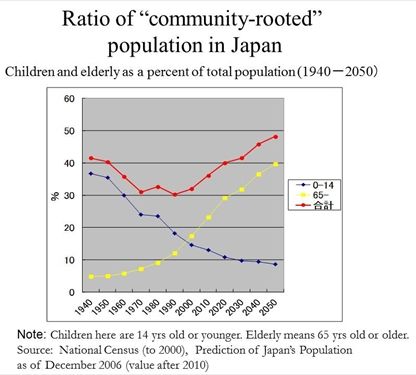
Copyright Yoshinori Hiroi All Rights Reserved.
Let's think about the community economy. In the figure of a pyramid, the top is the "market economy," the middle is the "community," and the base is "nature and the environment." The top of the pyramid was cut off in capitalism. Originally, economy and community were linked, but they began to break apart.
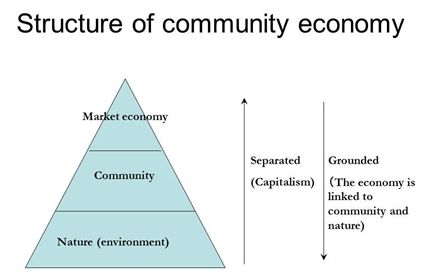
Copyright Yoshinori Hiroi All Rights Reserved.
What is the economy? It should include a kind of mutual cooperation in addition to a simple optimization of profit. Conversely, it is difficult to create a community when the economy is not involved. In short, a connection with some economic activity is essential for a practical community. In that sense, I think the community economy is important for the intent of reconnecting the community and the economy.
A community economy has four factors. The first is an economy's circulation within the community, which means an economy where people, goods, and money circulate in the area. In order to win the global competition, people sometimes get into the competition to keep the prices down by cutting costs. As a result, wages drop and people become trapped in a vicious cycle. Instead, we could create local circulation in the economy, to be more resilient in the face of globalization.
Iida City in Nagano Prefecture set a target to achieve an economic self-reliance ratio of 70 percent, aiming at creating industries that allow young people to return to their hometowns. The economic self-reliance ratio shows how much income needed for a community is supplied by the ripple effects of local industries. Specifically, it is calculated by dividing the total amount of multiplier-effect income from manufacturing, agriculture and forestry, and tourism industries in the South Shinshu area by the total amount of necessary income in the whole area (national average of real annual income per capita x total population of the South Shinshu area). The estimated figures were 52.5 percent in 2008, and 45.2 percent in 2009. Focusing on manufacturing, agriculture and forestry, and tourism industries in the area, we actively work to increase internal circulation.
As a nation, an international comparison on the export percentage of GDP shows that while many countries range from 30 to 40 percent, Japan actually has a low percentage of slightly above 10 percent. It has been overemphasized that Japan won't be able to survive without exporting, but Japan is in fact maintained by a high percentage of domestic consumption. In short, Japan has the potential to create an economy that circulates internally.
The second factor of a community economy is to connect the productive community and living community as much as possible. On the shopping streets and in rural villages, these two communities overlap greatly. In the United States, there may not be many shopping streets, but in Europe, including Germany, the whole town is a community space consisting of shopping streets. Revitalization of the economy and circulation within these areas appear to be very active.

Copyright Yoshinori Hiroi All Rights Reserved.
The third factor of the community economy is the mutual aid characteristic that an economy originally has. One example is that the ancient merchants in Ohmi area (currently Shiga Prefecture) had a motto, "sampou-yoshi," meaning that things would be good if three players were happy - the venders, the buyers, and society. Another is found in the words of Ei-ichi Shibusawa, a father of Japanese capitalism, in his book titled "Rongo to Soroban" (roughly translated as "the Analects of Confucius and the Abacus"). Shibusawa wrote: "Wealth will not last perpetually if it is not just and reasonable. In this regard, today we need to make efforts to match two opposites, like the analects of Confucius and the abacus." In today's context, it means that when we think about sustainability, the economy, and ethics, they will ultimately overlap each other.
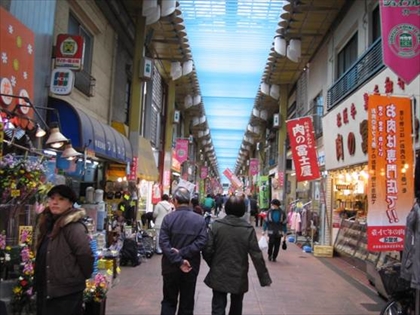
Copyright Yoshinori Hiroi All Rights Reserved.
The fourth factor of the community economy is redefining the concept of production in a finite context. This means a transformation from labor productivity to environmental efficiency, or an economy of using human resources more while saving resources. In other words, a labor-intensive area where productivity used to be low, such as welfare and education, will be more important, and investing in human resources will be essentially important, because the area where people take care of other people will be expanded.
One of the activities in which I am engaged is the "Chinju-no-mori" Alternative Energy Community Initiative. (Chinju-no-mori refers to the grove of ancient trees typically growing around a local village shrine). In Japan, we have 80,000 shrines and 80,000 temples, whereas the total number of convenience stores is 50,000. The number of middle schools in Japan is 10,000, so this means we have eight shrines and eight temples for each middle school. At shrines and temples, people would often open fairs and festivals, and they were the center of each local community. My interest is to connect such local centers with alternative energy and develop them as distributed, local energy resources connected with worship in nature. Alternative energy is to generate power using natural energy resources, and a local community's endeavors to use alternative energy means to restore autonomy and power back to the community.
Looking back to Japan's creation of social capital in the past, railway construction was the first stage, road construction and the use of the motor vehicle after World War II was the second stage, and the in the third stage, at the end of the period of rapid economic growth, waste disposal facilities and airports were constructed. The planning of these kinds of infrastructure should be made at a national level. But welfare, environment, culture and community building, all of which will be important in future, are essentially local. From the shift of economic structure, localization can also be a trend.
When thinking about a local economy, it is important to match it well with local traditions and culture, and with the inherent local setting. In fact, it is in the places where people really enjoy traditional festivals today in Japan that many young people remain, or return to their hometowns after spending several years in a city.
So far, there was a certain monolithic standard to judge communities as advanced or delayed. But, from now on, I believe the individuality and diversity of each local community will be placed at the forefront. Thus, we are welcoming the "landing" of an era of connecting the economy with community and nature, and leaving behind a capitalist economy in which the economy "took flight" or was separated from the community and nature.
Adapted from a lecture by Yoshinori Hiroi, the Social and Health Policy
Department, Faculty of Law and Economics, Chiba University
Summary by Junko Edahiro
Related
"JFS Newsletter"
- 'Good Companies in Japan' (Article No.4): 'Eightfold Satisfaction' Management for Everyone's Happiness
- "Nai-Mono-Wa-Nai": Ama Town's Concept of Sufficiency and Message to the World
- 'Yumekaze' Wind Turbine Project Connects Metro Consumers and Regional Producers: Seikatsu Club Consumers' Co-operative
- Shaping Japan's Energy toward 2050 Participating in the Round Table for Studying Energy Situations
- 'Good Companies in Japan' (Article No.3): Seeking Ways to Develop Societal Contribution along with Core Businesses


